Urinary System
Disorders and Overview
The Urinary System is another important body system. It works in conjunction with the lungs, skin, and intestines to remove waste from the body. The urinary system also works to reabsorb water, salts, protein, glucose, and minerals that are essential for cellular health. For optimal health, it is so important that all our body systems work together as a team.
The Urinary System is made up of the following:
- Kidneys
- Ureters
- Bladder
- Sphincter Muscle
- Uretha
Kidneys
The kidneys are the main organ of the Urinary System. The kidneys are bean-shaped and are approximately half the size of a fist. They are located in the middle of the back on each side of the spine. Each kidney contains approximately one million nephrons, which are responsible for the kidneys’ primary functions. The kidneys are crucial to our health, and without at least one fully functioning kidney, we can not live. They are responsible for filtering and processing the blood, removing waste from the body and producing the hormones erythropoietin (EPO), which stimulates bone marrow to make red blood cells; renin which helps regulate our blood pressure; and calcitriol, a form of Vitamin D that helps maintain the calcium for our bones and a normal chemical balance throughout the body.
The kidneys also regulate the balance of water, salts, proteins, glucose, minerals, urea, and other substances in the body, while helping to maintain the body’s pH balance. It is during the filtering and processing stage that urine is produced. The kidneys can only process approximately 4 oz of water at a time, so it is best to drink water in small amounts throughout the day. The ureters carry the urine from the kidneys to the bladder. Each ureter is approximately 8 to 10 inches long, and it is the muscles within the ureter walls that tighten and relax that move the urine from the kidney to the bladder. These muscles tighten and relax every 10 to 15 seconds.
Bladder & Urethra
The bladder is a balloon-shaped, hollow, muscular organ located in the pelvic area of the lower abdomen. The bladder is held in place by ligaments. When the bladder fills with urine, it fills like a balloon fills. The bladder can hold up to 2 cups for 2 to 5 hours and it is the nerves in the bladder that communicate, letting us know when it needs to be emptied. The sphincters are circular muscles located where the bladder connects to the urethra.
The urethra is the tube that transports the urine out of the body. The sphincters tighten to keep the urine from leaking out of the bladder, and when it is time to empty the bladder, the brain tells the bladder to tighten up to squeeze the urine out of the bladder, allowing the bladder to become smaller as it empties. Adults excrete approximately 1.5 quarts or more of urine each day.
Health Issues and Urinary System Disorders
Many problems can occur throughout the urinary system; a few are mentioned below.
- Urinary Tract Infections (UTIs)
- Urinary Incontinence
- Kidney Stones
- Chronic Kidney Disease
- Kidney Failure

UTI’s and Incontinence
Urinary tract infections (UTIs) affect millions of people each year and seem to be more common in women. Urinary tract infections can occur due to an obstruction in the flow of urine, changes in the immune system, insufficient fluid intake, and the presence of bacteria such as Escherichia coli (E. coli). Symptoms include pain or burning during urination, a strong odor, feelings of urgency or frequency, cloudy appearance, pus or blood, and passing a small amount even when you are feeling pressure. UTIs can be serious and can cause damage to the function of the kidneys. You can even have an infection present in the body where no signs are apparent. An ounce of prevention is worth a pound of cure. Have your doctor check your urine at each annual checkup.
Urinary incontinence is considered a bladder control problem and basically refers to leakage. It is more common in women as they age, but it can also affect young people. There are different types of incontinence. Stress incontinence is the most common type, meaning that leakage usually occurs when a person laughs, sneezes, coughs, or when pressure is applied to the lower abdominal muscles. The other is urge incontinence, which is when you feel you have to go, and this feeling comes on quickly and urgently. Incontinence stems from a wide range of cause,s including weakened muscles, infections, hormone imbalance, and nerve damage. Lifestyle choices can also contribute to problems. Alcohol, soda, and caffeine can stress and dehydrate the kidneys.
Kidney Health
Did you know that lower back pain can be a symptom of dehydration? Kidney stones are one of the most common and painful disorders. The occurrence of kidney stones is increasing, and they are more common in men than women. I have spoken to several women who have told me they would rather give birth than have another kidney stone. A kidney stone is typically composed of crystals that form in the kidneys. Crystals form for different reasons and are normally a combination of chemical elements. The most common being calcium combined with oxalate or phosphorus, which are part of a normal diet.
Chronic kidney disease is a reduction of kidney function that can result in kidney failure. The American Kidney Foundation stated that 20 million Americans suffer from chronic kidney disease and that 1 in 9 adults have it and don’t know it. Chronic kidney disease can be the result of a physical injury that causes damage to the kidneys, or a disease like diabetes or high blood pressure. Chronic kidney disease can be a contributing factor in other health issues like high blood pressure, low red blood cell count, diabetes, loss of protein through the urine, bone and calcium loss, cardiovascular and nervous system problems, and a lack of well-being.
Kidney failure, also known as renal failure, occurs when the kidneys are unable to regulate the water and chemicals in the body and remove waste products from the blood. This is when dialysis is necessary. There are more than one million people on dialysis worldwide, and current medical news suggests that this number can double over the next 10 years. This increases the number of kidney transplants required and the difficulty in finding a compatible one.
Lifestyle Solutions for a Healthier Urinary System
- Fresh air and sunshine
- Drink pure water
- Eat nutritious foods, which include plenty of fruits and vegetables
- Supplement with nutrients, including herbs
- Exercise daily and include strength training, stretching,g and flexibility, aerobic
- Detox – whether you take clay or aromatherapy baths, do foot detoxes, or far infrared saunas
- Get plenty of sleep
- Avoid toxins – try using natural personal care and cleaning products
- Create healthy relationships. Emotions play a crucial role in our overall well-being.
- Take time for yourself
- Prayer or meditation
Foods that are most nourishing for the urinary system are watermelon, cantaloupe, cucumbers, kidney beans, lemons, parsley, celery, cranberries, and asparagus. Calcium and Vitamin D are important for bone and kidney health. Hydrangea, the herb, has historically been known by the native Americans as a stone dissolver. Vitamin B Complex, along with Vitamin C, needs to be replenished daily because they are water-soluble vitamins.
Stress causes the body to demand more of these, and they are essential for nourishing the nervous system and maintaining our energy levels. Magnesium is also needed by the kidney’s and it is best to take both citrate and malate for easy assimilation. My mother-in-law was on kidney dialysis for over 3 years and avoided it for over five years, and I feel it was due to dietary changes that involved restricting protein and no sugar. She also took KB-C and CoQ10 from Nature’s Sunshine, as well as Kidney Stuff from Golden Standard.
View a list of Nature’s Sunshine Products that support this system by visiting our Urinary System Products Page. You can also take our Brilliant Body Health Assessment to help you determine which body system is in most need of support.
Written by Karen Stene Finch – All Rights Reserved.







